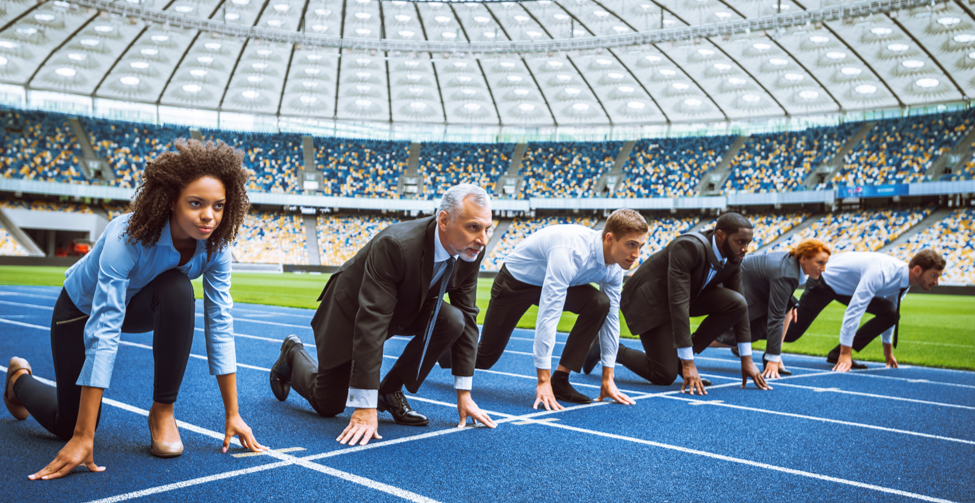Three Exercises Top-Performing Athletes Use that You Can Apply to Your Leadership Role
Much can be learned from top-performing athletes and their drive to succeed. Athletes focus on results and create a plan on how to achieve those results through rigorous training, prioritization, teamwork, and commitment. Athletes must avoid distractions and stay focused on the end goal. In many ways, the same is true for leaders. Leaders are constantly bombarded with information, problems, and pressures from everyone around them, and it can be easy to lose sight of what they are working toward. So, here are three exercises leaders can learn from top-performing athletes to help achieve optimal results.

1) Visualization: When you have to harness large amounts of energy on a single goal, visualize yourself achieving that goal first. Athletes use visualization to help them achieve their dreams. No athlete who has ever stood atop the winner’s podium did so without imagining that moment in advance—often many years prior to it happening. This vision of achievement guides and energizes athletes’ efforts through hours of practice, training, and sacrifice. In short, visualization will help energize you to work toward a desirable outcome and will help program your brain to realize what you need to do to achieve your goal. Here is how you do it:
- Start by identifying and writing down your goals. Be specific on exactly what you want to achieve, ensuring there is a viable outcome attached to the goal.
- Close your eyes and envision what success looks like. What does this success look, sound, and feel like? Try to be as vivid as possible.
- Regularly engage in visualizing both your short- and long-term goals.
2) Breathing: From the beginning of time, philosophers and scientists alike have described the link between the mind and body through the existence of our breath. We breathe without consideration of its occurrence because it is such a simple and intrinsic part of our lives, yet most people fail to breathe correctly. Using the right breathing technique has been found to increase feelings of happiness, relaxation, and well-being. When we breathe correctly, we can relieve pain, tension, and stress while enhancing our energy levels and quieting the mind. Breathing correctly oxygenates the body, enhances energy, removes toxins that accumulate throughout our body, and increases our immune system’s ability to overcome illness. Here is how you do it:

- Implement a simple breathing technique by inhaling slowly through your nose and into your abdomen. Your abdomen should inflate with your breath. Hold your breath for a moment. Exhale slowly through your nose. Continue to breathe in a slow, calm, and continuous manner.
- For a more advanced method, try Lifestream Breathing by Dr. Gay Hendricks. The steps are listed below:
- Gently and slowly arch and flatten the small of your back, taking 6–7 seconds to arch and 6–7 seconds to flatten. This causes you to rock forward and back on your sit bones. Rock your pelvis all the way to the front and all the way to the back.
- As you arch the small of your back, tilt your chin up toward the ceiling. As you flatten the small of your back, tilt your chin down toward the floor. The slower and gentler you can do it, the quicker your body will respond.
- Now, add your breathing to the movement. Breathe all the way into your relaxed belly as you arch the small of your back and look up. Then, breathe all the way out as you flatten the small of your back and look down.
- Position your hands so that you can feel your belly relax and expand when you breathe.
- Remember to take 6–7 seconds to breathe in, and 6–7 seconds to breathe out.
3) Activating the Right Brainwaves through Music and Meditation: Research has demonstrated a link between music and improved athletic performance. One study from researchers at the University in Nova Scotia found that women who listened to music ran a minute or two longer than those who didn’t. They also adjusted their strides to run more efficiently and had lower perceived exertion. Another study from Southwestern University in Texas found that men cycling at high intensity were able to exercise longer while listening to fast-paced music and even longer while listening to music they liked. Athletes work hard to reach a state of internal calm, harnessing their mind power to stay intense but not frantic. Music helps them get into that zone, offering flow, control, and focus. It helps them manage the pain of stressing their bodies to levels undreamed of by most. As such, it becomes a positive diversion. Music can similarly benefit leaders, helping us remove negative thoughts from our minds and allowing us to feel calmer and in control. So, when you start feeling stressed, frustrated, or irritated, grab some headphones and tune into your favorite playlist for a bit to reset your mind and attitude.
Meditation is also an effective tool for getting into the right headspace. Meditation helps with mindfulness, self-confidence, and compassion. As your concentration increases, you are able to accomplish more because your mind no longer distracts and doubts you. Overall, you are going to be healthier, happier, and more rested by meditating regularly. Meditation enables us to free our mind of unnecessary thoughts and brain activity; however, it differs from other relaxation techniques, because during meditation, you are more awake, alert, and better focused. Several studies have found that the more we meditate, the more relaxed, observant, and aware we become. Meditation allows us to achieve more because it helps us gain control over ourselves, minimizing the doubts, fears, and anxieties we all harbor. Just as athletes take a moment to meditate and breathe before a game, you too can use meditation to help calm, center, and focus yourself on the task ahead.
I hope that you will implement these three exercises in the new year to help you improve your leadership skills and achieve your desired results.
